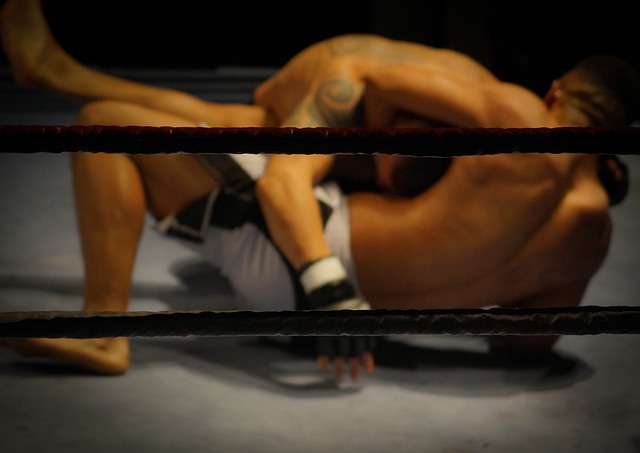A distinct and very difficult kind of entertainment, professional wrestling blends storyline, showmanship, and athleticism. Although the excitement that occurs inside the ring is well-known to spectators, what happens behind the scenes is as exciting. This piece will take you inside the professional wrestling scene, illuminating the demanding training regimens, demanding schedules, and tremendous enthusiasm that drive this fascinating industry.

Morning rituals:
The day of a professional wrestler usually starts early. They know how important it is to maintain optimal physical health, therefore going to the gym is often their first priority. Wrestlers put in a lot of training to keep up their strength, agility, and endurance since these qualities are necessary for carrying out their powerful maneuvers and keeping up an impressive look.
It’s time to pay attention to your diet after a strenuous exercise. Because their bodies are their most prized possessions, wrestlers are meticulous about what they eat. They eat a scientifically calibrated combination of healthy fats, carbs, and protein to aid in the development and repair of their muscles. Due to the intense physical demands of wrestling, it’s also critical to stay hydrated.
Promotion and Character Growth:
One of the most important aspects of the wrestling profession is character development. In addition to honing their mic skills and creating their character, wrestlers spend a lot of time practicing their promos, which are prepared statements that they give either in the ring or during interviews. These scenes are essential for developing narratives and holding viewers’ attention.
The skill of crafting an engaging promotional video should not be undervalued. Wrestlers have to remain faithful to their written identity while captivating the audience, communicating the reasons and feelings of their characters, and advancing the story. This often calls for improvisation and a keen grasp of the subtleties of their character.
Transport & Travel:
Professional wrestlers are athletes who move all the time. Wrestlers may be required to travel to many cities, states, and even other countries as part of the rigorous touring schedules of most promotions. This demanding travel schedule may be intellectually and physically exhausting. The wrestlers attempt to relax and recuperate for their next show during the long hours they spend on the road, sometimes on buses or rented automobiles.
One of the biggest sacrifices in a wrestler’s life is traveling. Wrestlers’ personal life may suffer as a result of spending so much time away from their loved ones. In this area of business, preserving connections and keeping in touch with loved ones becomes a special difficulty.
Event Readiness:
It’s time to start getting ready for the event as the day goes on. A few hours before the performance begins, wrestlers arrive at the location. This gives them time to discuss the bouts and plots for the evening with producers, the creative staff, and other wrestlers. To ensure that every action is expertly coordinated and that the narrative components are correctly transmitted, a lengthy rehearsal phase may be necessary.
During this period, wrestlers also warm up and prepare their bodies for the high-aggression nature of the bouts. Pre-show rituals include stretching, practicing movements, and taping up injuries.
Behind the Scene:
Wrestlers go “behind the curtain,” or backstage, when it’s time for the performance to begin. This is the point of magic. It’s a busy place full of stress, excitement, and friendship. It’s common to see wrestlers pacing, going over their notes, and getting ready for their match.
Devoted experts work tirelessly behind the scenes to make the show possible. The very imposing characters that viewers see on TV are the result of the painstaking labor of makeup artists, costume designers, and set builders. Seamstresses are always available to perform impromptu repairs since wardrobe malfunctions are a serious worry.

Around the Ring:
When the wrestler enters the ring, it is the moment of truth. There’s no denying the audience’s enthusiasm, jeers, and shouts. Although every move and second in the ring is meticulously rehearsed, there’s always a chance for error and danger. In order to thrill the crowd and bring the narratives to life, wrestlers risk their lives.
In professional wrestling, injuries are a terrible reality. Wrestlers often endure excruciating physical strain in order to complete a match because they are passionate about entertaining their fans and telling a compelling tale.
Rest and Recuperation:
The wrestler’s day is far from done after the match is over. Ice baths, massages, and trips to the trainer for any injuries received during the game are common post-show rituals. In order for them to play at their peak in the next games, they must fully recover.
Sleep is something that wrestlers need to schedule. Rest is vital because of the physical strain, travel, and scheduling pressures they face. The general health and performance of a wrestler may be negatively impacted by sleep deprivation over time.
Psychological Aspect:
The mental side of professional wrestling is just as important as the physical responsibilities. For wrestlers to handle the demands of the business, they need to possess a strong mental toughness. Even the most seasoned performers might suffer from burnout because to the demanding schedule, continual travel, and inherent danger of injury.
It’s difficult to concentrate and be true to yourself through all of the ups and downs. A thick skin is necessary for wrestlers to withstand the criticism they often get from both fans and detractors. Wrestlers push their boundaries in the quest of perfection and are always trying to outdo one other due to the competitive nature of the sport.
Creating and Maintaining Connections:
Keeping personal ties afloat in a field where artists must travel for a large chunk of the year may be hard. Despite their hectic schedules, wrestlers need to find methods to maintain their ties with friends, family, and significant others. This often calls for candid conversation and mutual understanding amongst all parties.
Furthermore, it is important to establish solid professional ties with other wrestlers. Hours of practice and joint performances create the chemistry and trust that exist in the ring. Within the wrestling world, these ties often transcend the squared circle, fostering a special kind of kinship.
Getting Ahead in Politics:
Professional wrestling has its fair share of politics, just like any other entertainment sector. A wrestler’s career may be impacted by negotiations, power conflicts, and creative disagreements that take place behind closed doors. Any performer has to be able to navigate and understand these dynamics.
Wrestlers often have to make pitches, stand up for themselves, and bargain for their places within the organization. A career in wrestling is highly dependent on reputation, and it is crucial to strike a balance between ambition and professionalism given the close-knit society.
The Cost to Individual Health:
Since professional wrestling is a physically demanding profession, accidents are a given. Sprains, strains, fractures, and more severe injuries that might have long-term implications are always a possibility for wrestlers. The physical toll may be severe, and many wrestlers still experience the repercussions years after their careers are over.
A greater understanding of the significance of wrestler health and safety has emerged in recent years. Promotions and organizations are taking steps to better safeguard their artists, including as tightening regulations on high-risk movements and improving medical practices.
The Benefits and Heritage:
Notwithstanding the difficulties, professional wrestling has special benefits. Few other occupations can equal the adrenaline of a well-executed competition, the roar of the audience, and the fulfillment of forming a personal connection with fans.
A wrestler’s legacy is shaped by their contributions to the business, the lives of their fans, and their accomplishments outside of the ring. Future generations will recognize and honor wrestlers who inspire and make a lasting impact on the wrestling community.
In summary:
A professional wrestler’s existence is not at all glamorous. It requires significant travel, a strong dedication to creativity, hard physical training, and the capacity to tolerate physical discomfort. But the love of what they do, the bond with their supporters, and the excitement of playing live are what really motivate these sportsmen.
The universe of effort, commitment, and sacrifice that goes on behind the scenes is sometimes invisible to the fans. A professional wrestler’s life is difficult, but it’s also full of exciting and successful moments that make it all worthwhile. In this world, chasing one’s dreams is paramount, and regardless of what transpires behind the scenes, the show must go on.

Common Questions about Becoming a Professional Wrestler:
1. How do wrestlers in the professional ranks prepare for matches?
Professional wrestlers follow intense training plans that include skill-based drills along with strength and conditioning routines. They strive to become more physically fit overall, hone their skills, and become experts at delivering stories in the ring.
2. Do pro wrestlers carry out their own antics?
Yes, in the ring, professional wrestlers execute their own maneuvers and antics. The physicality of the action is quite genuine, even if match results are set. In order to perform maneuvers properly and safeguard both themselves and their opponents, wrestlers undergo considerable training.
3. How often do wrestlers in the business travel for shows?
Depending on their degree of recognition and the organization they work for, professional wrestlers may travel sometimes or often. While some people may have a more flexible schedule, others could travel several days each week. Travel obligations may also increase due to pay-per-view events and international tours.
4. What kinds of injuries are typical for professional wrestlers?
A variety of ailments, like as sprains, strains, fractures, concussions, and more, may befall professional wrestlers. The physical demands of the job coupled with high-impact movements increase the chance of injury. Wrestlers and medical professionals collaborate closely to treat and recuperate from these wounds.
5. How do wrestlers create their egos and characters??
It takes imagination, teamwork with writers and promoters, and self-expression to develop a wrestling character. Wrestlers may take inspiration from their own lives, passions, or admired characters. The character is designed with an audience-engaging personality, past, and motives.
6. What safeguards are in place to ensure the wrestlers’ safety and welfare?
Promotions have taken a number of steps to put wrestler safety first. This covers stringent pre-game medical evaluations, procedures for concussions, and recommendations for high-risk movements. Additionally, there is a greater emphasis on offering mental health and wellbeing education and assistance.
7. How do wrestlers manage their personal obligations?
It may be difficult to juggle the responsibilities of a wrestling career with one’s personal life. In order to remain in touch with their loved ones while traveling, wrestlers often depend on open communication. Creating a network of support within the wrestling community may also aid in fostering understanding and stability.
8. How long does a professional wrestler typically stay in the business?
A professional wrestler’s tenure may vary greatly. Some people may have shorter careers than others because of injuries or other circumstances, while others may have decades-long, prosperous careers. Retirement choices are often influenced by personal objectives and circumstances.
9. Do professional wrestlers get to choose the plots and match formats?
Indeed, a lot of professional wrestlers contribute to their bouts’ plots. They exchange ideas and criticism with producers and creative teams. The story and character development in the promotion are shaped in part by this cooperative effort.
10. What are a few widespread misunderstandings about professional wrestling?
The idea that professional wrestling is wholly staged and artificial is one that is often held. The toughness and athleticism are quite genuine, even if the results are preordained. Another myth is that wrestlers never leave their characters; in reality, they often transition between their real-life identities and their on-screen personalities.
A fuller comprehension of the complexities and difficulties of the professional wrestler’s existence is offered by these FAQs. Professional wrestling is an extremely tough but rewarding career that calls for a special blend of talent, commitment, and enthusiasm. It involves everything from character development and safety precautions to training and travel.
